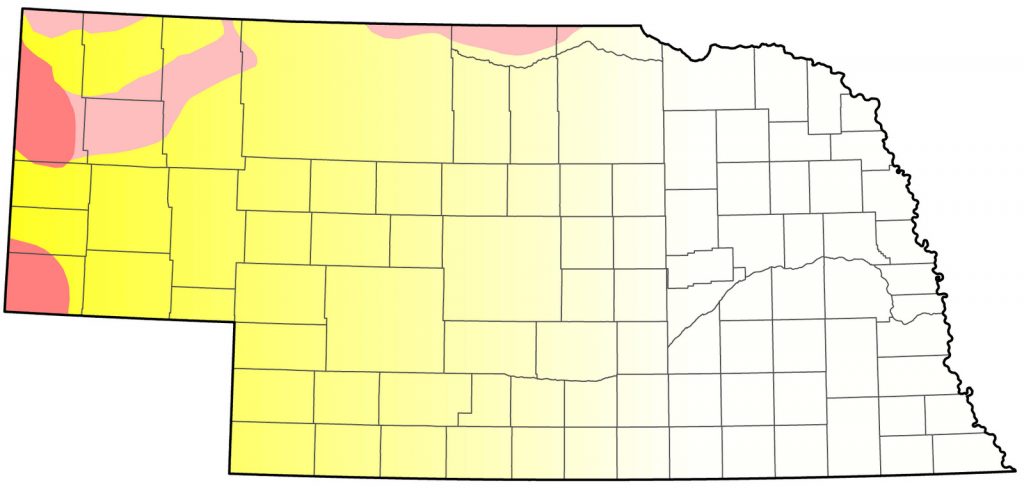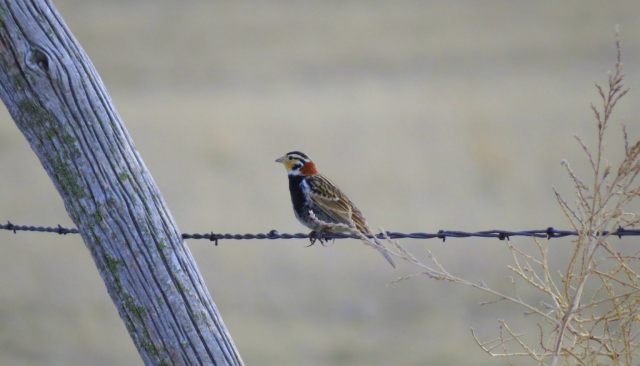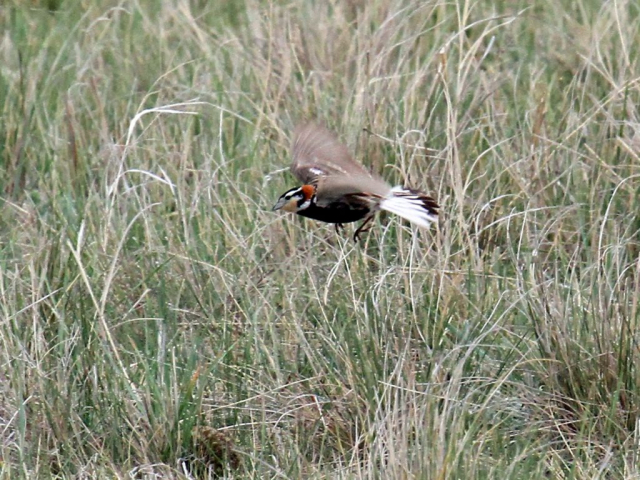Calcarius ornatus
Status: Fairly common regular spring and fall migrant west, uncommon central, rare east. Fairly common regular breeder west, locally uncommon north central.

Documentation: Specimen: UNSM ZM7614, 20 Mar 1900 Mullen, Hooker Co.
Taxonomy: No subspecies are recognized (AviList 2025).
Spring: Apr 3, 3, 3 <<<>>> May 6, 6, 7
Earlier dates are 6 Mar 1994 (25) Dixon Co, 14 Mar 2019 Buffalo Co, 18 Mar 2025 Buffalo Co, 29 Mar 2011 Custer Co, and 30 Mar 2023 Lincoln Co.
Late dates above are away from known breeding locations. A later date is 19 May 2022 in “sand prairie” in Garfield Co.
Reports for the east are 10 Apr 1997 Washington Co, 15-19 Apr 1986 Pierce Co, 15 Apr 1986 Dakota Co, and 21 Apr 1992 during a snowstorm Douglas-Sarpy Cos.
One collected near Oshkosh, Garden Co 5 May 1919 (UNSM ZM7611) was considered a migrant by Rosche (1994).
Migrants are regular in the Panhandle, where they are most common in wheat stubble (Rosche 1982) but are uncommon to rare elsewhere.
Easterly reports are few, although the species may be conspicuous after spring blizzards such as those of 14-15 April 1986 (Mollhoff 1986) and 10 Apr 1997. Easterly reports are of one near Creighton, Knox Co 7 Apr 2003 (Brogie 2004), three with Lapland Longspurs near Gretna, Sarpy Co 8 Apr 2003, 42 birds north of Blair in Washington Co in the 10 Apr 1997 blizzard, 14 Apr 1986 Dakota Co, 14-15 Apr 1986 Douglas-Sarpy Cos (Williams 1986), 15 Apr 1985 Dakota Co, 15 Apr 1986 Pierce Co, 21 Apr 1992 during a snowstorm Douglas-Sarpy Cos, and two in “short, grassy alfalfa” in Adams Co 21 Apr 2008.
Although a rare migrant as far east as the Missouri River, a Motus site at Hitchcock Nature Center in Pottawattamie Co, Iowa east of the river which can detect transmittered migrants as far as Nebraska, picked up a Chestnut-collared Longspur 22 Apr 2023 that had been banded in the Chihuahuan Desert at the Davis Mountains, Texas 24 Feb 2023.
- High counts: 1045 in southwestern Kimball Co 16 Apr 1997, 500+ near Crescent Lake, Garden Co 3 May 1978 (Williams 1978), “hundreds” in the Panhandle 15 Apr 2001, and 155 in Keith Co 17 Apr.
Summer: This species breeds primarily in the northern Great Plains (Bleho et al 2020); generally, low densities breed in Nebraska. BBS data (Sauer et al 2020) show a strong annual decline 1966-2019 of -3.54% (95% C.I.; -7.23, 0.33); “breeding populations in Nebraska … have been much reduced” (Bleho et al 2020). Mollhoff (2016) showed reports from only four BBA blocks during 2006-2011; three in Sioux County and one from Keya Paha County.
Chestnut-collared Longspur is most numerous in the Panhandle, where it breeds in native grasslands somewhat taller and moister than those used by McCown’s Longspur (Rosche 1982). Snyder and Bly (2009) surveyed McCown’s and Chestnut-collared Longspurs in Kimball Co in 2007 and found McCown’s to prefer heavily grazed shortgrass prairie and bare or virtually bare cropland, with minimal overlap with Chestnut-collared nesting areas, the latter preferring lightly grazed grassland.
The breeding range as outlined by Johnsgard (1980) extended northeastward “perhaps to Cherry County”; Youngworth (1955) reported breeding birds in northeast Cherry Co in 1932 and Ducey (1988) cited breeding season reports by Rosche eastward to pastures on the edge of the Sandhills in Cherry Co and “certain meadows” in Keya Paha Co. Although migrants are expected in the central into mid-Apr, somewhat tardy in northwestern Cherry Co in 2024 were seven at Shell Lake NWR 21 Apr, two at Abbott Ranch 22 Apr, and one at Henderson Ranch 17 Apr; these records are in the area cited by Ducey (1988) and support the possibility of breeding there. One was at Cottonwood Lake SRA, northwestern Cherry Co 5 Jun 1991. Two males were seen in a “historical nesting locality” in Keya Paha Co 29 May 1989 (Grzybowski 1989), and Brogie and Mossman (1983) reported three observations 11-14 May 1982, presumably in the same general area. More recently, there have been several May-Jul sightings in the Norden-Springview area of Keya Paha Co and at Hutton Sanctuary, Rock Co. In a survey for Burrowing Owls carried out in 2020 (Thiele et al 2021), several mid-May sightings (possibly migrants) of Chestnut-collared Longspurs in central Keya Paha Co and three birds in northwestern Keya Paha Co 27 Jul were suggestive of breeding.
Another northeastern location is in the O’Neill area of Holt Co, where one was present 17 Sep 1989 a few miles northeast of O’Neill and summering birds were there 21 May-17 Aug 1991 (Blake and Ducey 1991) and again in 1992, when 20 were seen 5 May (Grzybowski 1991). There have been several reports since those in May-Jul in Holt Co, most in the area about five miles east and 2-4 miles north of O’Neill, where “about 35” were noted 14-31 Jul 1996 (Grzybowski 1996, Silcock and Rosche 1994), and in 2020 one on 3 Jun and 2 on 6 Jul. In 2021 two were there 28 May and in 2023 1-5 were reported in spring, 20 Apr-11 May, although these may have been migrants.
Away from the above locations, it may have bred near Lake McConaughy, Keith Co where an apparent family group of six was found 7 Aug 2000, and one was at NNF McKelvie, Cherry Co 19 Jun 2015. One was at Willy Lake, Sheridan Co 29 Jun 2022.
- Breeding phenology:
Eggs: 4 Jun
Nestlings: 30 May-27 Jun - Fledglings: 12 Jul
- High counts: 42 in Sioux Co 27 Jun 2023, and 30 on Henry Road, Sioux Co 9 Jun 2023.
Fall: summer <<<>>> Oct 11, 12, 12
Later dates are 15 Oct 2019 Kearney Co, 18 Oct 1995 Perkins Co, 20 Oct 2024 Sioux Co, 21 Oct 2024 McPherson Co, 25 Oct 2023 near Kilgore, Cherry Co, 29 Oct 1996 at Crescent Lake NWR, Garden Co, and 8 Nov 2018 (20) Custer Co.
There is insufficient information to determine early dates for fall migration in Nebraska, although movement of small flocks from breeding areas begins in mid-Sep (Bleho et al 2020); two were at Lake McConaughy 25 Aug 2006. Departure ends by late Sep.
Easterly reports are fewer than in spring, the only ones tangibly documented a first-winter bird photographed in Adams Co 24 Sep 2006 and photos of three at Prairie Dog WPA, Kearney Co 8 Oct 2023.
- High counts: 753 in southwestern Kimball Co 13 Oct 1998, 150 at Clear Creek WMA, Keith and Garden Cos 26 Sep 1999, and 107 at Lake McConaughy 12 Oct 2000.
Images
Abbreviations
BBA: Breeding Bird Atlas
BBS: Breeding Bird Survey
NNF: Nebraska National Forest
NWR: National Wildlife Refuge
SRA: State Recreation Area
UNSM: University of Nebraska State Museum
WMA: Wildlife Management Area (State)
Literature Cited
AviList Core Team, 2025. AviList: The Global Avian Checklist, v2025. https://doi.org/10.2173/avilist.v2025.
Blake, L., and J. E. Ducey. 1991. Birds of the eastern Sandhills in Holt County, Nebraska. NBR 59: 103-132.
Bleho, B., K. Ellison, D.P. Hill, and L.K. Gould. 2020. Chestnut-collared Longspur (Calcarius ornatus), version 1.0. In Birds of the World (P. G. Rodewald, Editor). Cornell Lab of Ornithology, Ithaca, NY, USA. https://doi.org/10.2173/bow.chclon.01.
Brogie, M.A. 2004. 2003 (15th) Report of the NOU Records Committee. NBR 72: 59-65.
Brogie, M.A., and M.J. Mossman. 1983. Spring and summer birds of the Niobrara Valley Preserve, Nebraska: An annotated checklist. NBR 51: 44-51.
Cortelyou, R.G. 1980. 1980 (Fifty-fifth) Spring Occurrence Report. NBR 48: 70-87.
Ducey, J.E. 1988. Nebraska birds, breeding status and distribution. Simmons-Boardman Books, Omaha, Nebraska, USA.
Grzybowski, J.A. 1989. Southern Great Plains Region. American Birds 43: 499-501.
Grzybowski, J.A. 1991. Southern Great Plains Region. American Birds 45: 466-469.
Grzybowski, J.A. 1996. Southern Great Plains Region. Field Notes 50: 965-968.
Johnsgard, P. A. 1980. A preliminary list of the birds of Nebraska and adjacent Great Plains states. Published by the author, University of Nebraska, Lincoln, USA.
Mollhoff, W.J. 1986. Chestnut-collared Longspurs. NBR 54: 68.
Mollhoff, W.J. 2016. The Second Nebraska Breeding Bird Atlas. Bull. Univ. Nebraska State Museum Vol 29. University of Nebraska State Museum, Lincoln, Nebraska, USA.
Rosche, R.C. 1982. Birds of northwestern Nebraska and southwestern South Dakota, an annotated checklist. Cottonwood Press, Crawford, Nebraska, USA.
Rosche, R.C. 1994. Birds of the Lake McConaughy area and the North Platte River valley, Nebraska. Published by the author, Chadron, Nebraska, USA.
Sauer, J.R., W.A. Link and J.E. Hines. 2020. The North American Breeding Bird Survey – Analysis Results 1966-2019. U.S. Geological Survey data release, https://doi.org/10.5066/P96A7675, accessed 27 Jul 2023.
Silcock, W.R., and R.C. Rosche. 1994. Summer Field Report, June-July 1994, NBR 62: 102-116.
Snyder, L., and B.L. Bly. 2009. Differential use of agricultural fields and rangeland nesting habitat by McCown’s Longspur (Calcarius mccownii) and Chestnut-collared Longspur (Calcarius ornatus) in Western Nebraska. NBR 77: 35-41.
Thiele, J., M. Brogie, J. Corman, S. Nevison, R. Olson, K, Schumacher, and C. Wessel. 2021. 2020 Keya Paha River Watershed Burrowing Owl Surveys, Including Records of Other At-risk Species – Final Report. Nebraska Game and Parks Commission, Norfolk, Nebraska, USA.
Williams, F. 1978. Southern Great Plains Region. American Birds 32: 1024-1028.
Williams, F. 1986. Southern Great Plains Region. American Birds 40: 491-494.
Youngworth, W. 1955. Some birds of the Quicourt Valley. NBR 23: 29-34.
Recommended Citation
Silcock, W.R., and J.G. Jorgensen. 2025. Chestnut-collared Longspur (Calcarius ornatus). In Birds of Nebraska — Online. www.BirdsofNebraska.org
Birds of Nebraska – Online
Updated 22 Jul 2025


